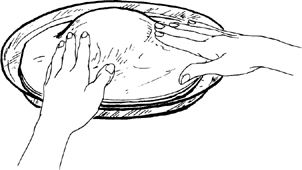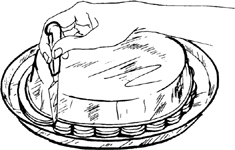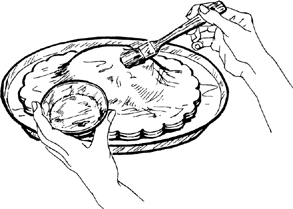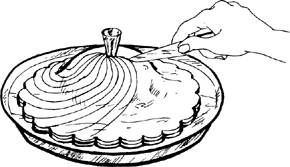Mastering the Art of French Cooking, Volume 2 (201 page)
Read Mastering the Art of French Cooking, Volume 2 Online
Authors: Julia Child

With lightly floured fingers as well as the side of your hand, |
|
| Turn a cake pan or bowl upside down over |
(*)
AHEAD-OF-TIME NOTE
:
Pithiviers
may be refrigerated or frozen at this point; chill to harden dough, then cover airtight. (Frozen pastry may be taken directly from freezer, and glazed and decorated as soon as top of dough is soft enough for a knife to penetrate it.)
When oven is preheated to 425 degrees, and just before baking, |
|
| With the point of a sharp small knife, cut decorative design into pastry as shown, going ⅛ inch deep. |
3)
Baking—about 50 minutes at 450 degrees and 400 degrees
As soon as
Pithiviers
has been glazed and decorated, set in middle level of preheated 450-degree oven. In 20 minutes, or when pastry has risen and browned nicely, reduce oven heat to 400 degrees and continue baking 25 to 30 minutes more, until sides of pastry are brown and crisp. If
Pithiviers
seems to be browning too much during baking, lay a sheet of brown paper or foil loosely over the top.
4)
Sugar glaze
About ⅓ cup confectioner’s sugar in a fine-meshed sieve
A cake rack
Remove
Pithiviers
from oven, set thermostat at 500 degrees, and slide oven rack onto upper-third level.
Remove funnel. Sieve a
1
⁄
16
-inch layer of the sugar over the top of the
Pithiviers
. When oven is at 500 degrees, set pastry in upper third for 4 to 5 minutes, peeking quickly every 30 seconds, until sugar has melted to a glossy sheen. Remove the
Pithiviers
and slide it onto the rack.
5)
Serving and storing
A
Pithiviers
may be eaten tepid or cold, but is always at its best when freshly made and served within 2 to 3 hours of baking. It will keep successfully for a day in a warming oven at 100 degrees, or you may freeze it when cold and wrapped airtight. If frozen, thaw for about 30 minutes on a lightly buttered pastry sheet in a 350-degree oven.
To serve, cut into wedges, like a pie.






